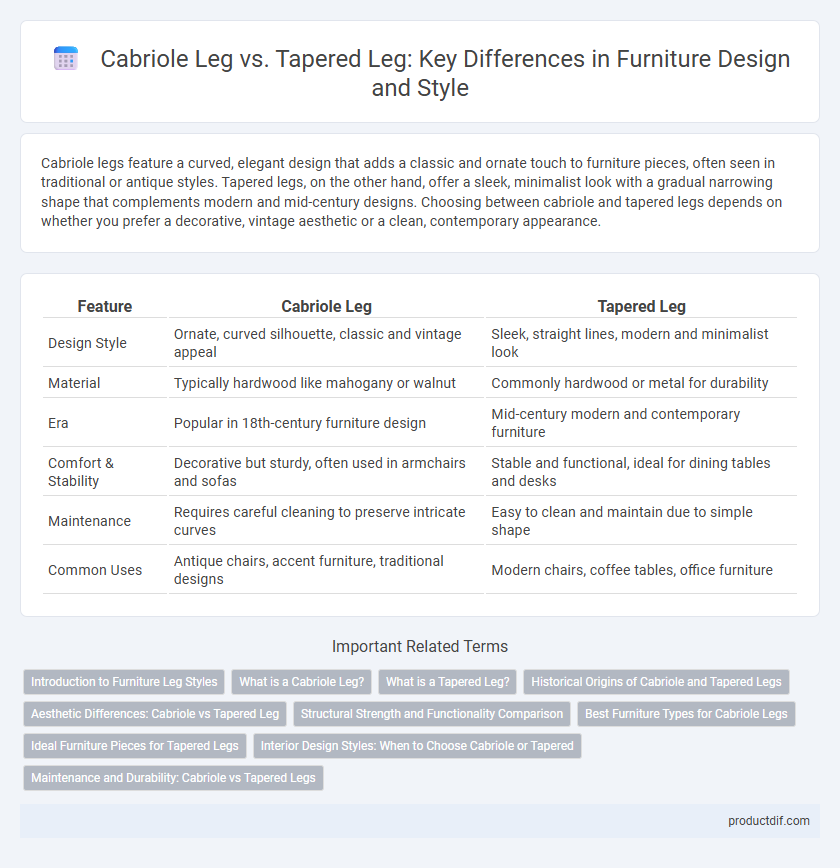Cabriole legs feature a curved, elegant design that adds a classic and ornate touch to furniture pieces, often seen in traditional or antique styles. Tapered legs, on the other hand, offer a sleek, minimalist look with a gradual narrowing shape that complements modern and mid-century designs. Choosing between cabriole and tapered legs depends on whether you prefer a decorative, vintage aesthetic or a clean, contemporary appearance.
Table of Comparison
| Feature | Cabriole Leg | Tapered Leg |
|---|---|---|
| Design Style | Ornate, curved silhouette, classic and vintage appeal | Sleek, straight lines, modern and minimalist look |
| Material | Typically hardwood like mahogany or walnut | Commonly hardwood or metal for durability |
| Era | Popular in 18th-century furniture design | Mid-century modern and contemporary furniture |
| Comfort & Stability | Decorative but sturdy, often used in armchairs and sofas | Stable and functional, ideal for dining tables and desks |
| Maintenance | Requires careful cleaning to preserve intricate curves | Easy to clean and maintain due to simple shape |
| Common Uses | Antique chairs, accent furniture, traditional designs | Modern chairs, coffee tables, office furniture |
Introduction to Furniture Leg Styles
Cabriole legs, characterized by their elegant S-shaped curves, are a hallmark of traditional and antique furniture styles, often seen in Queen Anne and Chippendale pieces. Tapered legs, featuring a sleek, straight design gradually narrowing towards the bottom, are commonly found in mid-century modern and contemporary furniture, emphasizing simplicity and functionality. Understanding these distinct leg styles enhances furniture selection, enabling a choice that complements interior design themes and structural preferences.
What is a Cabriole Leg?
A cabriole leg is a distinctive furniture leg characterized by its elegant double-curved shape, resembling an animal's leg with a convex upper curve and a concave lower curve, often ending in ornamental feet like a claw-and-ball or pad foot. This design emerged during the 18th century, prominently featured in Queen Anne and Chippendale furniture styles, symbolizing sophistication and craftsmanship. The flowing silhouette of cabriole legs enhances the aesthetic appeal of chairs, tables, and cabinets, making them a timeless choice for classic and antique-inspired interiors.
What is a Tapered Leg?
A tapered leg in furniture design is characterized by a leg that gradually narrows from top to bottom, creating a sleek, streamlined silhouette. Commonly crafted from wood or metal, tapered legs are favored for their mid-century modern appeal and ability to complement minimalist interiors. This design not only enhances stability but also adds an elegant, understated aesthetic to tables, chairs, and sofas.
Historical Origins of Cabriole and Tapered Legs
Cabriole legs originated in the early 18th century, inspired by animal forms and prominent in Queen Anne and Chippendale furniture styles, symbolizing elegance and craftsmanship. Tapered legs emerged later during the mid-20th century, reflecting modernist design principles with clean, straight lines and a minimalist aesthetic. These distinct historical origins highlight the evolution of furniture leg design from ornate, nature-inspired curves to sleek, functional geometry.
Aesthetic Differences: Cabriole vs Tapered Leg
Cabriole legs feature an elegant, S-shaped curve inspired by French Rococo design, adding a sense of classic sophistication and ornate craftsmanship to furniture pieces. Tapered legs present a sleek, straight silhouette that narrows toward the floor, embodying a modern, minimalist aesthetic often found in mid-century and contemporary furniture. The choice between cabriole and tapered legs significantly impacts the visual style, with cabriole legs emphasizing traditional, decorative appeal and tapered legs enhancing a clean, streamlined look.
Structural Strength and Functionality Comparison
Cabriole legs offer enhanced structural strength due to their curved design, which distributes weight evenly and provides superior stability for heavy furniture pieces like tables and chairs. Tapered legs, characterized by their straight, narrowing form, emphasize sleek aesthetics but may sacrifice some load-bearing capacity, making them better suited for lightweight or decorative furniture. Functionally, cabriole legs excel in durability and support, while tapered legs prioritize modern style and ease of cleaning underneath furniture.
Best Furniture Types for Cabriole Legs
Cabriole legs, characterized by their elegant S-shaped curves and ornamental detailing, are best suited for classic furniture types such as Queen Anne chairs, Chippendale tables, and antique-style cabinets. These legs complement pieces that emphasize traditional craftsmanship and intricate design, enhancing the overall aesthetic with a regal and vintage appeal. Ideal for living rooms and formal dining areas, furniture with cabriole legs adds an element of sophistication and timeless charm.
Ideal Furniture Pieces for Tapered Legs
Tapered legs are ideal for mid-century modern and Scandinavian furniture, enhancing clean lines and minimalist designs in chairs, coffee tables, and dressers. Their slender and angled silhouette provides a light, airy appearance, perfect for smaller spaces seeking elegance without bulk. Furniture pieces with tapered legs often feature wood finishes like walnut or oak, complementing contemporary and transitional interiors.
Interior Design Styles: When to Choose Cabriole or Tapered
Cabriole legs, with their elegant curves and ornate detailing, suit traditional, vintage, and French Provincial interior design styles, adding a sense of luxury and historical charm. Tapered legs, characterized by straight, sleek lines that narrow towards the floor, complement modern, mid-century, and Scandinavian aesthetics, promoting minimalism and clean, geometric forms. Choosing between cabriole and tapered legs hinges on whether the space calls for intricate craftsmanship and classic appeal or streamlined simplicity and contemporary flair.
Maintenance and Durability: Cabriole vs Tapered Legs
Cabriole legs, with their intricate curves and ornate detailing, require more careful cleaning and maintenance to prevent damage and preserve their finish, making them less durable in high-traffic areas compared to tapered legs. Tapered legs, characterized by their simple, straight lines and solid construction, offer greater durability and are easier to clean, often withstanding heavy use without showing significant wear. Choosing tapered legs enhances long-term furniture longevity and minimizes upkeep, especially in busy environments.
Cabriole Leg vs Tapered Leg Infographic

 productdif.com
productdif.com